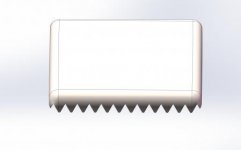Hello all,
I'm working with a Charmilles Robofil 510, and I'm having an issue trying to machine an open profile with 0.004" wire. Everything seems to be working correctly, though I am using a wire that doesn't match the available thin wire technologies that the machine has. Specifically, this is brass wire, not zinc coated brass, and I only have access to ST10.WIR and ST10A.TEC (the zinc coated brass files).
Unspooling is smooth, with no pigtailing, and there are no issues with brake tension.
When I rough into a solid piece I have no issues. Roughing a punch or die works just fine, but I'm having a hell of a time roughing when it's an open profile for some reason. The wire snaps the moment the spark ignites and I can't figure out why. I've tried adjusting the average pulse voltage, the pulse lengths, the frequency, and everything else that I can think of or know to adjust, but there's no change.
I am machining teeth into a very small plate that will lock into an opposing rack to stop the movement of a slide (see the attached pictures). I reworked the base blank that I am machining into and figured that with the small amount of material that needs to be removed (<.010") I could just let the finish passes handle it, but it constantly hangs up and warns of a short.
The shorts happen at every peak of a tooth. When it warns of a short, I back the wire off the profile, return it to the contour, and then it starts up like nothing happened until the next peak.
Occasionally, random pieces will simply snap the wire instead of shorting. I don't know what to do or how better to describe the issue.
Any help is greatly appreciated.


I'm working with a Charmilles Robofil 510, and I'm having an issue trying to machine an open profile with 0.004" wire. Everything seems to be working correctly, though I am using a wire that doesn't match the available thin wire technologies that the machine has. Specifically, this is brass wire, not zinc coated brass, and I only have access to ST10.WIR and ST10A.TEC (the zinc coated brass files).
Unspooling is smooth, with no pigtailing, and there are no issues with brake tension.
When I rough into a solid piece I have no issues. Roughing a punch or die works just fine, but I'm having a hell of a time roughing when it's an open profile for some reason. The wire snaps the moment the spark ignites and I can't figure out why. I've tried adjusting the average pulse voltage, the pulse lengths, the frequency, and everything else that I can think of or know to adjust, but there's no change.
I am machining teeth into a very small plate that will lock into an opposing rack to stop the movement of a slide (see the attached pictures). I reworked the base blank that I am machining into and figured that with the small amount of material that needs to be removed (<.010") I could just let the finish passes handle it, but it constantly hangs up and warns of a short.
The shorts happen at every peak of a tooth. When it warns of a short, I back the wire off the profile, return it to the contour, and then it starts up like nothing happened until the next peak.
Occasionally, random pieces will simply snap the wire instead of shorting. I don't know what to do or how better to describe the issue.
Any help is greatly appreciated.





 F*^k IT and walking out. I tried everything in my knowledge and beyond. My boss came in to help and told me to change the spool of wire and then walked out. I figured he had stopped at the bar during lunch but humored him. I'll be damned if that machine all of a sudden worked.
F*^k IT and walking out. I tried everything in my knowledge and beyond. My boss came in to help and told me to change the spool of wire and then walked out. I figured he had stopped at the bar during lunch but humored him. I'll be damned if that machine all of a sudden worked. 